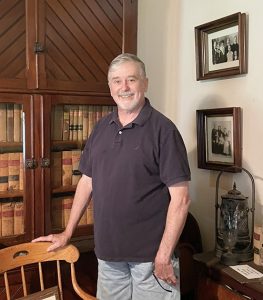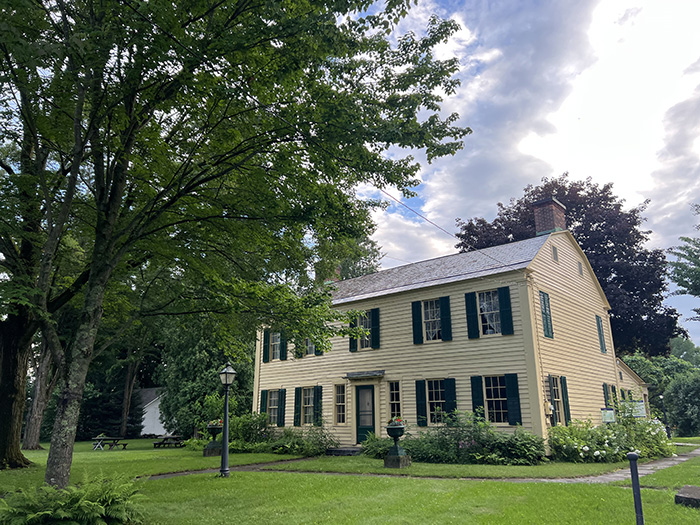By Hannah Hughes, Chronicle Summer Staff
The Old Fort House Museum in Fort Edward reaches a milestone this week.

“We’re ready to celebrate our 70th year, and to me, that’s a major milestone.” said Paul McCarty, Fort Edward Historian and Executive Director of the Old Fort House. July 12 is the day that the Fort Edward Historical Association officially acquired the property on Lower Broadway to preserve and run it as a museum.
The celebration on Wednesday, July 12 will begin at 4:30 p.m. with a cake cutting and small ceremony, and will feature Assemblywoman Carrie Woerner, association president Elizabeth O’Leary, and Mr. McCarty as speakers.
The Old Fort House building has been around since the Revolutionary War era, one of few local buildings so old.
Now, the museum’s three-acre campus not only houses the Old Fort House itself, but other historical buildings like the Riverside Schoolhouse and the Cronkhite Pavillion, an old building from the former Washington County Fairgrounds.
“If we didn’t relocate [these buildings] they were going to be flattened…And so we decided to begin the collection of some of these structures for the museum to use,” said Mr. McCarty.
He adds, “Every little town can have a museum, but when you consider that our museum has a pedigree of so many important people having passed through its doors,” it’s unique, said Mr. McCarty.
These figures include the future President George Washington and Solomon Northup, the man who wrote the memoir 12 Years A Slave, the basis for the 2013 film of the same name.

Mr. McCarty said The Old Fort House is also the birthplace of Washington County government and was used to hold court — all because Patrick Smyth, a representative to the King of England, built the house in 1772.
“There are a lot of these historical connections which I think are so important,” said Mr. McCarty.
He said they work hard to provide educational opportunities, including classroom presentations on figures like Washington, Northup, Jane McCrea and Duncan Campbell, as well as topics like Native Americans, Fort Edward Pottery, and others.
Their on-site tours allow kids to visit not only the museum’s campus, but the Rogers Island Visitors Center and the Old Champlain Canal.
“It’s just wonderful to see… the light bulbs go on when [the kids] experience something.” Mr. McCarty said.
He said the museum has been praised for its accuracy and authenticity.
“One of the other things that I’m most proud of, under my watch, is that we’ve been able to acquire furnishings which are from this area…Most everything that you see here was used here or owned by families from here,” said Mr. McCarty.
“We’re trying to make it authentic.”
Maintaining and running the property comes with challenges. “Because of the last couple of years, and not being able to get much in the way of help, we’ve had to kind of slow some things down and do what we could do,” said Mr. McCarty.
He hopes eventually the museum can support more staff and volunteers, especially with new projects and advances the Old Fort House has coming up.
Mr. McCarty would like to open the museum’s area for rotating exhibits, and he said the town and village of Fort Edward are working on developing a shared historical archive, which will help the museum with storage and other aspects. He believes this is a big step for the town and the Old Fort House.
“I think we’re going to discover things that we didn’t know that we had, and two, I think we’re going to be able to show some of the strengths of our collection, which are quite good, that I think most people are totally unaware of. The archive is very important,” he said.
As for the future of the Old Fort House, Mr. McCarty thinks finding someone to take over will be his biggest challenge.
“It’s a hard and difficult situation…You can hire a professional person, but will they have an interest? I hope that before I’m out of the picture, that I can at least identify somebody in the picture who has an interest.”
Mr. McCarty’s own passion remains strong. “With history, you keep learning things, you can never say ‘Oh, well, history, I’ve read it all, I’ve seen it, it’s done!’ History is never done. There’s always a new way to look at something, interpret something, research something, and with our technology today that is just changing.”
Copyright © 2023 Lone Oak Publishing Co., Inc. All Rights Reserved
 Glens Falls Chronicle Serving the Glens Falls/Lake George region; Warren, Washington and northern Saratoga counties since 1980
Glens Falls Chronicle Serving the Glens Falls/Lake George region; Warren, Washington and northern Saratoga counties since 1980

